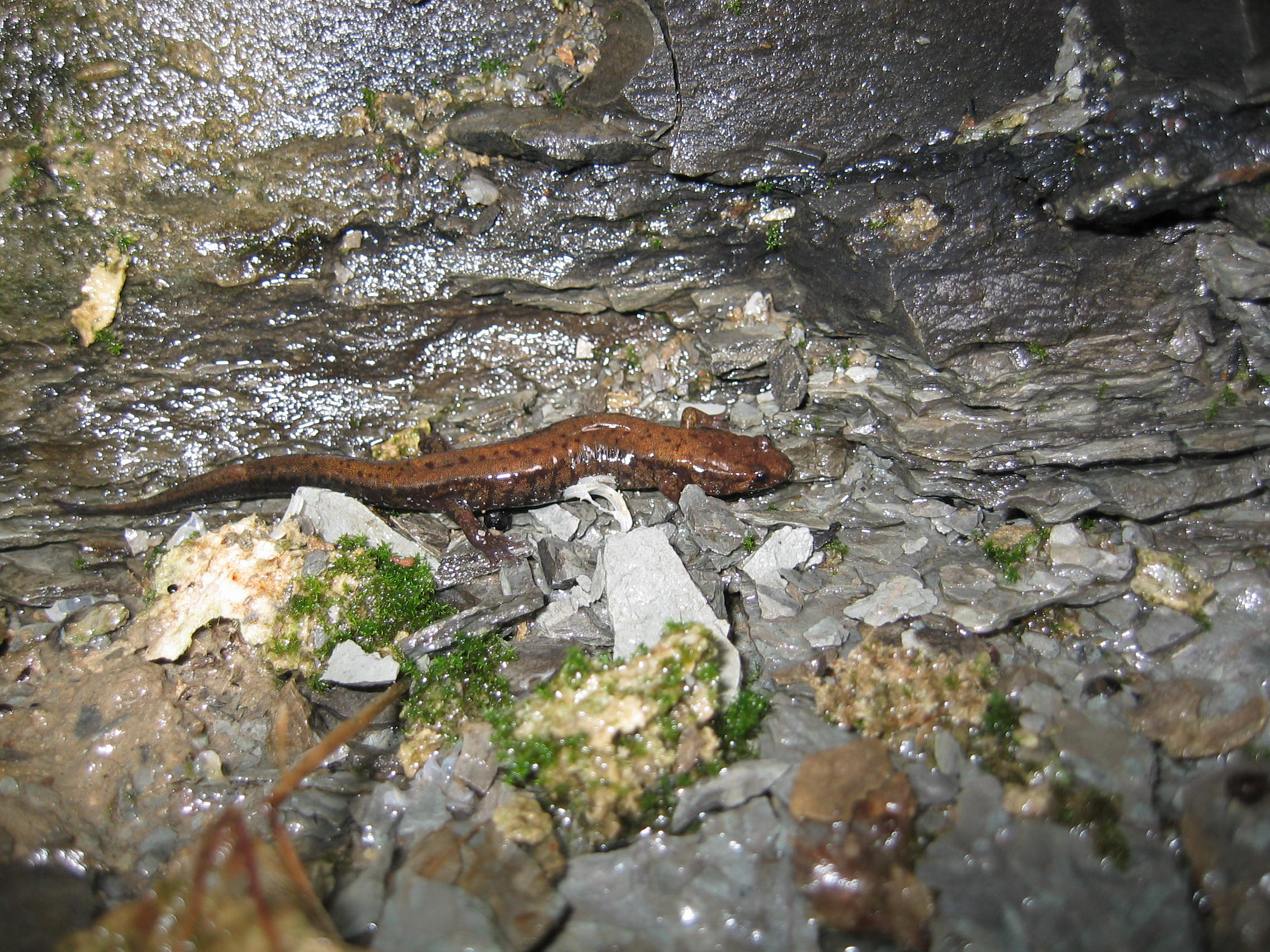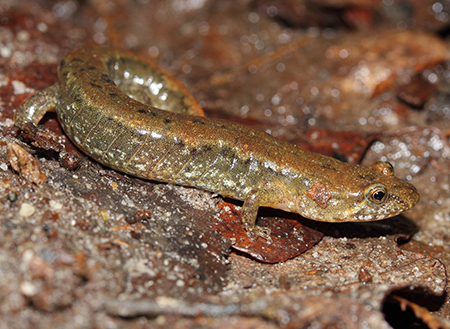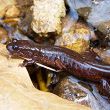Allegheny Mountain Dusky Salamander and Northern Dusky Salamander


Species information
This chapter provides a review of progress towards the protection and recovery of Allegheny Mountain Dusky Salamander (Desmognathus ochrophaeus) and Northern Dusky Salamander (Desmognathus fuscus) in Ontario from 2007 to 2017.
The Allegheny Mountain Dusky Salamander ranges in size from 7 to 11 centimetres in length and the Northern Dusky Salamander is 6 to 14 centimetres long. For both species, the male is larger than the female. Colouring is variable but both species have a distinctive dorsal stripe that runs from mouth to tail. The Allegheny Mountain Dusky Salamander is typically more brightly coloured with a dorsal stripe that is yellow to red with chevron-shaped dark patches alongside the stripe and an underside that is dark. The Northern Dusky Salamander has a tan or brown stripe with no markings and a pale cream-coloured underside.
Like other salamanders of the family Plethodontidae, these species do not have lungs; instead, oxygen is absorbed through the skin and the mucous membrane in the mouth and throat. Because these breathing surfaces must remain moist at all times, the species inhabit damp shady woodland environments including areas along streams, under structures such as logs and rocks, and in the leaf litter of the forest floor. They are most active at night when they emerge from under cover objects. Eggs are laid in the spring or fall, in clusters on the undersides of logs and rocks, in mossy areas, or amidst organic debris such as leaf litter. In 6 to 10 weeks, the salamander larvae hatch and enter nearby waters, inhabiting slow-moving streams and seeps until they metamorphose into adults. Both larvae and adults feed on a wide range of invertebrates such as spiders, beetles, earthworms, snails, mites, aphids and insect larvae.
Both species are widely distributed throughout the northeastern United States but have very restricted ranges in Canada. In Ontario, the two species are known to occur only in the Niagara Gorge where the very specific habitat features they require are found. The distribution of suitable habitat sites is so limited that dispersal of the Niagara populations to other areas in southern Ontario is considered to be extremely unlikely.
With their similar biology, habitat needs, limited distribution and very small range sizes in Ontario, Allegheny Mountain Dusky Salamander and Northern Dusky Salamander face virtually identical threats to their survival and recovery. A single random event, such as an extensive mudslide, could have severe consequences for both species as they inhabit such small areas. Other threats include disruption or contamination of groundwater discharge sources, and habitat degradation from erosion, off-trail hiking, tree removal and the spread of the invasive European Common Reed (Phragmites australis australis) into sensitive habitat areas.
The survival and recovery of the two species are influenced by other factors as well. More research is required to determine if the species’ genetic diversity is limited due to their small population sizes. The resultant inbreeding could affect the species’ reproductive success and cause genetic defects. Also, collection for the pet trade could have serious impacts on the persistence of these species.
The Allegheny Mountain Dusky Salamander is listed as endangered at the provincial level (Species at Risk in Ontario List). At the federal level, the species was split into two populations in 2012 as the Carolinian population and the Great Lakes / St. Lawrence population. The Carolinian population occurs in Ontario, and is listed as endangered on Schedule 1 of the Species at Risk Act (SARA). Globally, this species is considered to be secure (NatureServe Explorer).
The Northern Dusky Salamander is listed as endangered at the provincial level (Species at Risk in Ontario List). At the federal level, the species was split into two populations in 2012 as the Carolinian population and the Quebec / New Brunswick population. The Carolinian population occurs in Ontario, and is listed as endangered on Schedule 1 of the Species at Risk Act (SARA). Globally, the species is considered to be secure (NatureServe Explorer).
Provincial status
Prior to the Endangered Species Act, 2007 (ESA or the Act
), the Committee on the Status of Species at Risk in Ontario (COSSARO) assessed the Allegheny Mountain Dusky Salamander as endangered but the species was not listed until 2008 when the ESA came into effect. Northern Dusky Salamander was also assessed as endangered, and was regulated under the previous Endangered Species Act in 2003. The species has retained its status as endangered under the ESA. In 2012, COSSARO reassessed the species, and its status as endangered was reconfirmed.
In future assessments, COSSARO may consider information gained through protection and recovery actions regarding the species’ threats and trends in population and distribution.
Species and habitat protection
Protecting Allegheny Mountain Dusky Salamander and Northern Dusky Salamander and their habitats are key components in the implementation of the ESA and continue to be government-led actions, as identified in the government response statement (GRS).
As an endangered species, Allegheny Mountain Dusky Salamander has been protected from being killed, harmed, harassed, captured or taken under the ESA since it came into force in 2008.The species’ habitat has been protected from being damaged or destroyed since June 30, 2013, based on the general habitat definition in the ESA.
As an endangered species that was regulated under the previous Endangered Species Act, Northern Dusky Salamander has received species and habitat protection since 2003 and retained these protections under the ESA. The Act prohibits the species from being killed, harmed, harassed, captured or taken and its habitat from being damaged or destroyed. Habitat protection for the species is based on the general habitat definition in the Act.
The ESA does not require a habitat regulation to be developed for transition
Any person who negatively impacts Allegheny Mountain Dusky Salamander, Northern Dusky Salamander or their habitats without prior authorization may be prosecuted under the ESA.
Allegheny Mountain Dusky Salamander has been protected from being killed, harmed, harrassed, captured or taken since 2008.
In addition, the habitat of Allegheny Mountain Dusky Salamander has been protected from being damaged or destroyed since 2013.
Northern Dusky Salamander has been protected from being killed, harmed, harrassed, captured or taken since 2003.
In addition, the habitat of Northern Dusky Salamander has been protected from being damaged or destroyed since 2003.
Recovery strategy
A recovery strategy for Allegheny Mountain Dusky Salamander and Northern Dusky Salamander was published on January 11, 2013, which was in advance of the date required by the ESA. Recovery strategies are advice to government and represent the best available scientific knowledge. The strategy identifies the habitat needs of the species and the threats that they face, while recommending objectives and approaches for their protection and recovery. The recovery strategy also includes recommendations on the areas of habitat to be considered in the development of a habitat regulation.
Government response statement
The government published the GRS for Allegheny Mountain Dusky Salamander and Northern Dusky Salamander on October 11, 2013, which was within the timeframe required by the ESA. The GRS is the Government of Ontario’s species-specific policy on what is needed to protect and recover the species, and includes an associated recovery goal.
To help achieve this goal, the government leads, supports and prioritizes recovery actions identified in the GRS. Common actions for the government to lead as it works towards achieving a species’ recovery goal are provided in section 2.5 of the Species at Risk Program Status (2008-2015). In addition to the common actions, a government-led action that is specific to these salamander species is:
- Protect and manage the surface water and groundwater system that sustains the seep and stream habitat of the Allegheny Mountain Dusky Salamander and Northern Dusky Salamander through continued water budget assessments that determine the quantity and quality of the water moving within the local area of the Niagara Gorge and any natural or human activities that influence the system.
Recovery goal
The government’s goal for the recovery of Allegheny Mountain Dusky Salamander and Northern Dusky Salamander is to maintain suitable habitat conditions in the Niagara Gorge in order to retain existing known populations in a self-sustaining state and promote natural increases.
The GRS for Allegheny Mountain Dusky Salamander and Northern Dusky Salamander also lists six actions the government supports others to undertake for the species. These government-supported actions fall under the objectives identified in the GRS, which are:
- Assess and improve knowledge of the species' demographics and physical environment in Ontario
- Maintain suitable habitat, particularly groundwater quantity and quality, and minimize threats from adjacent land uses
- Raise awareness and promote collaboration in the protection and recovery of the Allegheny Mountain Dusky Salamander and Northern Dusky Salamander in Ontario
Allegheny Mountain Dusky Salamander timeline
Northern Dusky Salamander timeline
Government-funded projects
An important government-led action in the GRS for Allegheny Mountain Dusky Salamander and Northern Dusky Salamander is to support partners to undertake activities to protect and recover the species.
Partners reported that provincial funding helped them to secure in-kind support by involving 18 individuals who volunteered 38 hours of their time towards protection and recovery activities that focused exclusively on Northern Dusky Salamander, which has an estimated value of $4,000. As well, 3,037 individuals volunteered 17,036 hours of their time towards protection and recovery activities for multiple species at risk, including Allegheny Mountain Dusky Salamander and Northern Dusky Salamander, which has an estimated value of $362,720.
A stewardship partner reported that through both their efforts and the efforts of their volunteers to implement actions contained in the GRS, they were successful in enhancing four hectares of habitat that will benefit Northern Dusky Salamander and providing focused outreach to 350 individuals. In addition, for multi-species projects that included Allegheny Mountain Dusky Salamander and Northern Dusky Salamander, stewardship partners reported providing broader media outreach to more than 58,000 individuals.
The remainder of this section highlights a project supported through the Species at Risk Stewardship Program as well as the corresponding government-supported recovery actions for the Northern Dusky Salamander.
The Niagara Parks Commission (NPC) received funding through the Species at Risk Stewardship Program to implement measures to protect and restore habitat for Northern Dusky Salamander. Visitors to the natural areas managed by the NPC can experience a rich diversity of plant and animal life supported by unusual and rare habitats, in particular the Niagara Glen area. As part of managing Niagara parklands, the mandate of the NPC is to protect sensitive habitat areas from the impacts of human use. The main goal of the project was to reduce access to sensitive salamander habitat areas and divert visitor traffic to less sensitive areas. Project elements included:
- Installing an engineered steel staircase and accessible ramp to keep visitors off sensitive slopes where trampling had caused eroded sediments to flow down into salamander habitat
- Planting of more than 200 native trees and shrubs along the edge of the rim of the Whirlpool Gorge to naturalize former mowed areas; 300 more were planted on the gorge walls to reduce soil erosion and provide shade for seep areas. As they mature, the trees and shrubs will also reduce the speed and flow of water flowing down the gorge wall that was damaging salamander habitat. Altogether, 1.6 hectares of habitat were restored
- Laying down and securing coir matting, a biodegradable geo-fabric, to further stabilize the whirlpool rim banks and cover over unsanctioned trails
- Installing approximately 250 metres of post and rail fencing along the upper rim of the Whirlpool Gorge to discourage visitors from venturing onto the unstable gorge slopes to reach the trail below
This project supports the GRS actions to work with stakeholders, engineers and contractors to implement beneficial management practices that minimize impacts on groundwater recharge areas and seeps, and to plant native trees to reduce hillside erosion and deforestation.
Species at Risk Stewardship Fund
-
 6
6projects included Allegheny Mountain Dusky Salamander and Northern Dusky Salamander
-
 1
1project for Northern Dusky Salamander exclusively
-
 $487,696
$487,696or all 6 projects that included Allegheny Mountain Dusky Salamander and Northern Dusky Salamander
-
 $1,123,355
$1,123,355in additional funding and in-kind support
-
 3,037
3,037volunteers
-
 17,036
17,036volunteer hours
-
 58,000
58,000people received outreach
-
 4
4hectares of habitat enhanced
Efforts to minimize adverse effects on Allegheny Mountain Dusky Salamander and Northern Dusky Salamander
Supporting partners through permits and their associated conditions is an important government-led action.
Since the species became protected under the ESA, seven ‘protection or recovery’ permits (i.e., 17(2)(b)) have been issued for one or both of these species. ‘Protection or recovery’ permits are issued if the purpose of the activity is to assist in the protection or recovery of a species at risk. All of the permits were issued to enable field surveys to monitor populations and gather species occurrence information. One permit was issued for only Northern Dusky Salamander; another for only Allegheny Mountain Dusky Salamander, and five for both species.
One activity that may affect Allegheny Mountain Dusky Salamander or its habitat has been registered under ‘Threats to health and safety, not imminent’ (section 23.18) of Ontario Regulation 242/08 under the ESA.
The registration requires the registered individual to comply with all conditions of the regulation, such as:
- Implementing a mitigation plan developed by an expert on the species that includes steps to minimize adverse effects on the species and its habitat (for example, avoiding the activity during a time of year when the species is carrying out a life process such as reproduction)
- Reporting observations of the species to the government using the Ontario Species at Risk Observation Reporting Form and submitting it to the Natural Heritage Information Centre
-
7protection or recovery permits
-
1registration
Occurrences of Allegheny Mountain Dusky Salamander and Northern Dusky Salamander in Ontario
One population
Since 2008, the government’s central repository at the Natural Heritage Information Centre (NHIC) has received eight records of Allegheny Mountain Dusky Salamander, based on observations made between 2009 and 2013, and 43 records of Northern Dusky Salamander, based on observations made between 2004 and 2011. There have been a total of 18 observations of Allegheny Mountain Dusky Salamander and 71 observations of Northern Dusky Salamander recorded in Ontario since 1989.
In 1989, two salamander populations were discovered in the Niagara Gorge that were identified and documented as Northern Dusky Salamander. It was not until 2004 that one of the populations was proven to be the Allegheny Mountain Dusky Salamander. In 2010, Allegheny Mountain Dusky Salamanders were observed at another site about 500 metres away. This additional site is considered to be the part of the same population.
Observations for both Allegheny Mountain Dusky Salamander and Northern Dusky Salamander come from a variety of sources. Records submitted have helped to refine where the species are known and have been known to occur and have provided additional information on the species’ habitats and threats. Observations have confirmed that the two species are restricted to limited areas in the Niagara Gorge, where the highly specific habitats they require exist.
It is possible that there are observations of Allegheny Mountain Dusky Salamander and Northern Dusky Salamander that have not been submitted to the government. Encouraging the submission of observations of these species to the government is included in the GRS as a government-led action. Submission of species observations increases our knowledge of where they occur and can play an important role in assessing the viability of species populations.
Everyone is encouraged, or may be required by an authorization or approval, to submit observations of Allegheny Mountain Dusky Salamander and Northern Dusky Salamander, and any other species at risk observed, to the NHIC for incorporation into the provincial record of observations.
8 observations of Allegheny Mountain Dusky Salamander were submitted to the NHIC since 2008
43 observations of Northern Dusky Salamander were submitted to the NHIC since 2008
Summary of progress towards meeting the recovery goal
Summary of progress
Progress has been made towards all of the government-led actions and the majority of the government-supported actions outlined in the GRS for Allegheny Mountain Dusky Salamander and Northern Dusky Salamander. The Government of Ontario has directly undertaken actions to:
- Protect and manage the surface water and groundwater system that sustains the seep and stream habitat of the Allegheny Mountain Dusky Salamander and Northern Dusky Salamander through continued water budget assessments that determine the quantity and quality of the water moving within the local area of the Niagara Gorge and any natural or human activities that influence the system
- Educate other agencies and authorities involved in planning and environmental assessment processes on the protection requirements under the ESA
- Encourage the submission of Allegheny Mountain Dusky Salamander and Northern Dusky Salamander data to the government’s central repository at the NHIC or the Ontario Reptile and Amphibian Atlas
- Undertake communications and outreach to increase public awareness of species at risk in Ontario
- Protect the Allegheny Mountain Dusky Salamander and Northern Dusky Salamander and their habitat through the ESA
- Support conservation, agency, municipal and industry partners, and Indigenous communities and organizations to undertake activities to protect and recover the Allegheny Mountain Dusky Salamander and Northern Dusky Salamander. Support will be provided through funding, agreements, permits (including conditions) and/or advisory services
- Establish and communicate annual priority actions for government support in order to encourage collaboration and reduce duplication of efforts
Government-supported actions are organized under recovery objective focus areas. Progress has been made towards all of the government-supported recovery objectives and a number of the associated actions identified in the GRS for Allegheny Mountain Dusky Salamander and Northern Dusky Salamander.
Under the objective to assess and improve knowledge of the species’ demographics and physical environment in Ontario, progress has been made towards two of the four sub-actions listed under Action No. 1 – High Priority:
- Develop and implement a standardized survey and monitoring program for the Allegheny Mountain Dusky Salamander and Northern Dusky Salamander and their habitat to:
- Conduct searches of suitable unoccupied habitat along the Niagara Escarpment and Fonthill Kame Moraine for undiscovered populations
- Monitor population levels and trends
These two actions have been carried out by staff from the Ministry of Natural Resources and Forestry’s Niagara area office, as well as by partner organizations and citizen scientists. Ministry staff from the Niagara area office have conducted searches in the Niagara Gorge, and began long-term monitoring of these two species in 2005 using cover boards. Monitoring activities have resulted in the gathering of important information on local distribution and relative abundance of these species.
Under the objective to maintain suitable habitat, particularly groundwater quantity and quality, and minimize threats from adjacent land uses, progress has been made towards two of the three actions:
- Work with stakeholders, engineers, and contractors to implement beneficial management practices that minimize impacts on groundwater recharge areas and seeps. Water budget modelling can help to forecast and identify potential impacts caused by changing land and water uses (Action No. 3 – High Priority)
- Plant native trees to reduce hillside erosion and deforestation and create stormwater management ponds to capture and slow down runoff of herbicides, pesticides and other pollutants (Action No. 4)
These actions have been implemented through projects supported by the Species at Risk Stewardship Program to protect Northern Dusky Salamander habitat. One of the projects involved the installation of an engineered steel staircase to keep hikers away from a sensitive area and another project resulted in the planting of hundreds of native trees and shrubs along steep gorge walls to stabilize the soil and shade important seepage areas.
Under the objective to raise awareness and promote collaboration in the protection and recovery of the Allegheny Mountain Dusky Salamander and Northern Dusky Salamander in Ontario, considerable progress has been made towards the single action to:
- Prepare educational materials such as pamphlets to inform park visitors about the endangered status of these salamanders and the need to not disturb them or their habitat, and to discourage off-trail hiking (Action No. 6).
This action has been implemented through species at risk outreach and recovery education programs in the Niagara Gorge area, including projects funded through the Species at Risk Stewardship Program. For example, the smartphone application developed as part of the Ontario Reptile and Amphibian Atlas increases opportunities for citizen science and raises awareness of these species in Ontario. In 2010, the Ontario Dusky Salamander Recovery Team produced the Quebec and Ontario Stream Salamander Stewardship Guide that provides information for landowners and stewardship partners to assist in the conservation of these species. The Ministry of Natural Resources and Forestry’s Niagara area office has also contributed to achieving this action through the production and distribution of educational outreach materials about these species and their conservation needs.
The recovery goal for Allegheny Mountain Dusky Salamander and Northern Dusky Salamander is to maintain suitable habitat conditions in the Niagara Gorge in order to retain existing known populations in a self-sustaining state and promote natural increases. Efforts made towards the government-led and government-supported actions, including habitat restoration and protection, landowner outreach and long-term monitoring, have helped to make progress towards the recovery goal for these two salamander species.
Recommendations
As stated in the GRS, this review of progress can be used to help identify whether adjustments are needed to achieve the protection and recovery of the species. Based on progress to date, the overall direction provided in the GRS for Allegheny Mountain Dusky Salamander and Northern Dusky Salamander should continue to guide protection and recovery of the species, particularly those actions identified as high priority in the GRS. Relative to actions that have received a higher level of support, the following action has received less support and should be a priority for implementation in the future:
- Develop and implement a standardized survey and monitoring program for the Allegheny Mountain Dusky Salamander and Northern Dusky Salamander and their habitat (Action No.1 – High Priority) including:
- Monitor changes in slope stability and erosion rates on hillsides in the species’ habitat
- Monitor population levels and trends
- Monitor genetic health of the populations to detect potential inbreeding
Another action for which progress has been limited and should continue to be a high priority in future implementation planning is to:
- Develop an integrated program to measure, forecast, and detect changes in the quantity and quality of water supporting the species’ habitat (Action No. 2 – High Priority) including:
- Developing a water budget model
- Characterizing and simulating the surface water and groundwater system and contaminant transport
- Assessing water use and land use scenarios
- Measuring seasonal and yearly averages of the flows of seeps and streams
- Integrating the monitoring of climate, surface and groundwater within the local area of the Niagara Gorge
Although some progress has been made toward the remainder of the government-supported actions for the Allegheny Mountain Dusky Salamander and Northern Dusky Salamander, further work to implement all of the actions is required, including investigating whether the removal of European Common Reed will improve or negatively impact the quality of the habitat (Action No. 5). This invasive non-native plant eliminates habitat used by the salamanders, but also helps to stabilize the slope and prevent soil erosion.
Although considerable progress has been made toward the action to monitor population levels and trends, ongoing monitoring is essential to detecting changes in trends and informing future threat mitigation and recovery planning. This action should be continued for these species.
Moving forward, protecting and recovering Allegheny Mountain Dusky Salamander and Northern Dusky Salamander will continue to be a shared responsibility that will require the involvement of many individuals, organizations and communities. Financial support for the implementation of actions may be available through the Species at Risk Stewardship Program. The government can also advise if any authorizations under the ESA or other legislation may be required to undertake a project. By working together, progress can continue to be made towards protecting and recovering Allegheny Mountain Dusky Salamander and Northern Dusky Salamander in Ontario.
Summary of progress towards the protection and recovery of Allegheny Mountain Dusky Salamander and Northern Dusky Salamander (2007 to 2017)
Provincial status
Allegheny Mountain Dusky Salamander is classified as endangered under the Endangered Species Act, 2007 (ESA). It was previously listed as endangered on the Species at Risk in Ontario List, but was not regulated under the previous Endangered Species Act. The species has been protected from being killed, harmed, harassed, captured or taken under the ESA since 2008, and its habitat has been protected from damage or destruction under the ESA since 2013.
Northern Dusky Salamander is classified as endangered under the ESA. It was also listed under the previous Endangered Species Act, and has retained the same status since transition to the ESA. Northern Dusky Salamander has received species and habitat protection since 2003.
Species-specific documents and guidance published by the government
- Recovery Strategy for Allegheny Mountain Dusky Salamander and Northern Dusky Salamander (2013)
- Allegheny Mountain Dusky Salamander and Northern Dusky Salamander: Ontario Government Response Statement (2013)
Government-supported stewardship projects
- Through the Species at Risk Stewardship Program, the Government of Ontario has enabled its stewardship partners to conduct six projects ($487,696) that supported the protection and recovery of Allegheny Mountain Dusky Salamander and/or Northern Dusky Salamander projects. One project focused exclusively on Northern Dusky Salamander and five projects focused on multiple species at risk, including both Allegheny Mountain Dusky Salamander and Northern Dusky Salamander.
- Partners reported that provincial funding helped them to secure in-kind support by involving 3,077 individuals who volunteered 17,036 hours of their time towards protection and recovery activities for multiple species at risk, including Allegheny Mountain Dusky Salamander and Northern Dusky Salamander, which has an estimated value of $362,720. The estimated value of these voluntary contributions, as well as additional funding and in-kind support, is $1,123,355.
- Stewardship partners reported that through their actions four hectares of habitat were enhanced for Northern Dusky Salamander and other species at risk that inhabit the same ecosystem.
- Stewardship partners reported providing focused outreach on multiple species at risk, including Allegheny Mountain Dusky Salamander and Northern Dusky Salamander to more than 58,000 individuals.
Supporting human activities while ensuring appropriate support for species recovery
- The government has issued seven ‘protection or recovery’ permits under clause 17(2)(b) of the ESA for one or both of these species.
- One activity has been registered for Allegheny Mountain Dusky Salamander. The activity was registered under ‘Threats to health and safety, not imminent’ (section 23.18) under Ontario Regulation 242/08 of the ESA.
Occurrences and distribution
One population of Allegheny Mountain Dusky Salamander (at two sites separated by about 500 metres) and one population of Northern Dusky Salamander have been observed in Ontario. The populations of both species are considered to be extant (i.e., observed within the past 20 years). In 1989, when first observed in Ontario, both populations were thought to be Northern Dusky Salamander. In 2004, it was discovered that one of the populations was in fact the Allegheny Mountain Dusky Salamander. In 2010, individuals of this species were discovered at another location nearby that are considered to be part of the same population.
Related information
- Categorizing and Protecting Habitat under the Endangered Species Act
- Natural Heritage Information Centre
- Ontario’s Endangered Species Act
- Ontario’s Endangered Species Act Regulation 242/08
- Ontario Recovery Strategy and Government Response Statement for Allegheny Mountain Dusky Salamander
- Ontario Recovery Strategy and Government Response Statement for Northern Dusky Salamander
- Policy Guidance on Harm and Harass under the Endangered Species Act
- Species at Risk in Ontario List
- Species at Risk Stewardship Program
Footnotes
- footnote[1] Back to paragraph A transition species, for the purposes of this report, is an endangered or threatened species listed under schedule 1, 3, or 4 of the ESA that has not changed in status since June 2008.
- footnote[2] Back to paragraph Some projects supported through the Species at Risk Stewardship Program may require a 17(2)(b) permit in order to carry out the project. As a result, some 17(2)(b) permits indicated in section 7 of this report may have been issued to authorize those projects.
- footnote[3] Back to paragraph A population is defined as an area of land and/or water on/in which an element (for example, Allegheny Mountain Dusky Salamander) is or was present. They are comprised of one or more observations and the area has a practical conservation value as it is important to the conservation of the species. An element occurrence is the technical term used to describe this.